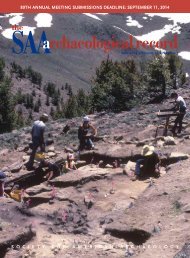SAA
SAA_Record_Nov2015
SAA_Record_Nov2015
You also want an ePaper? Increase the reach of your titles
YUMPU automatically turns print PDFs into web optimized ePapers that Google loves.
IN MEMORIAM<br />
ELLIOTT M. LAX<br />
1959–2015<br />
Archaeology lost a cherished friend when Elliott M. Lax<br />
died on February 5, 2015, in Tucson, Arizona, after a<br />
protracted battle with melanoma. Elliott Lax was a gifted<br />
teacher and passionate mentor who dedicated much of his<br />
life to the vital but underappreciated role of serving as a<br />
bridge between general education and archaeology.<br />
In the fall of 1991, one chapter in Elliott’s life closed but<br />
another opened. Elliott left graduate school to focus on teaching.<br />
Although he was the chemistry teacher at St. Gregory<br />
High School in Tucson, he convinced the<br />
administrators to let him teach a course on<br />
anthropology. I was one of six students who<br />
signed up. Elliott brought the human story to<br />
life with his expertise and enthusiasm. More<br />
significantly, he dedicated himself to drawing<br />
us out of the classroom into experiences that<br />
gave us a taste of the excitement of the field.<br />
We took a field trip to Chaco Canyon. We dug<br />
alongside researchers at a Hohokam platform<br />
mound. The next year Elliott personally<br />
taught me the basics of zooarchaeology.<br />
Elliott took me to my first <strong>SAA</strong> annual meeting<br />
when I was still a pimply high schooler.<br />
This approach of gentle inspiration—making anthropology<br />
exciting, then tapping his network to offer students unique<br />
opportunities—became Elliott’s pedagogical hallmark. He<br />
inspired a string of students to pursue archaeology. From that<br />
first class alone, two of us received anthropology degrees.<br />
Other former students who studied archaeology because of<br />
Elliott’s mentorship include Lauren M. Kingston (Casa<br />
Grande Ruins National Monument), Estee Rivera Murdock<br />
(Saguaro National Park), and Erin M. DenBaars (Arizona<br />
State Museum). All of them expressed to me that Elliott was<br />
special not only because he could make science accessible but<br />
also because he treated everyone’s dreams as important.<br />
“When I was a kid, he always made me feel like an adult, and<br />
when I was an adult, he made me feel like a peer,” Estee wrote<br />
me. “In the years after high school, I was always excited to run<br />
into him and see the genuine enthusiasm he had to see anyone<br />
succeed and be passionate about their work.”<br />
Elliott himself discovered archaeology during high school,<br />
when he had the chance to excavate at the Koster Site, an<br />
archaic-period village in southern Illinois. He went on to<br />
receive an undergraduate degree from the University of<br />
Chicago. For graduate school, Elliott attended the University<br />
of Arizona, first receiving an MA in anthropology in 1984; he<br />
then transferred to the geosciences program. Friends recall<br />
that Elliott was frustrated by his graduate school experience.<br />
But none remember him as embittered. Elliott was persistently<br />
optimistic; little could inhibit his wonderful quirks, quick<br />
wit, and serious smarts. He was a kind soul. And although<br />
Elliott did not become a full-time archaeologist, he found his<br />
calling as an educator in Tucson. After St. Gregory, Elliott was<br />
a successful science teacher at Catalina Foothills High School<br />
and then played a key role for nearly a decade in chartering<br />
City High School. In 2013, he became the school coordinator<br />
at Refugee Focus, which provides safety to<br />
immigrant families fleeing persecution.<br />
Yet, through the years, archaeology remained<br />
Elliott’s touchstone. He conducted fieldwork<br />
nearly every year, traveling to Greece, Cyprus,<br />
Brazil, Bolivia, Hawaii, and throughout<br />
southern Arizona. He was a dedicated member<br />
of two volunteer-driven organizations in<br />
Tucson, Old Pueblo Archaeology Center and<br />
Archaeology Southwest. Between 2003 and<br />
2008, Elliott contributed as an instructor to a<br />
$2.9 million National Science Foundation<br />
grant at the University of Arizona, which<br />
involved an interdisciplinary training program<br />
in archaeological sciences for K-12 teachers. Because<br />
archaeology is not a required subject in Arizona curriculum,<br />
Elliott and his colleagues deployed great ingenuity to smuggle<br />
the discipline into subjects like earth sciences and history.<br />
Elliott’s eagerness to share archaeology and his perennial<br />
good-naturedness was perfectly on display one summer day<br />
in 1996. Elliott had become a part-time field director at Sabino<br />
Canyon Ruin, a Hohokam site being excavated by Old Pueblo<br />
Archaeology. A fellow high school teacher of his, Robert<br />
Mossman, had wanted to dig and Elliott welcomed him. That<br />
day, Mr. Mossman recently wrote me, they found a beautiful<br />
ceramic vessel—large and seemingly intact. They painstakingly<br />
uncovered it. They had the pot almost completely<br />
exposed when, suddenly, it collapsed into pieces. Mr. Mossman<br />
was crestfallen. But Elliott laughed with an impish grin.<br />
“Don’t worry, it happens all the time,” Elliott said. “Now someone<br />
just gets to put it together!”<br />
—Chip Colwell, current <strong>SAA</strong> Board Member and Curator of<br />
Anthropology at the Denver Museum of Nature and Science<br />
40 The <strong>SAA</strong> Archaeological Record • November 2015




